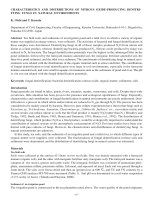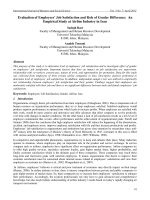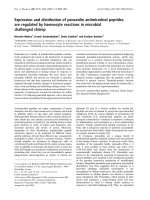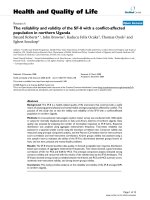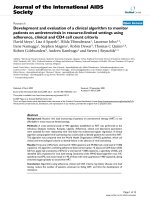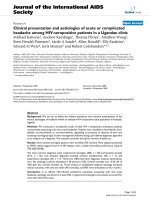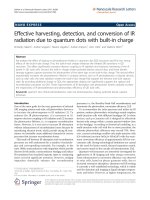Characteristics and applicability of Granulated Blast Furnace Slag (GBFS) as construction materials in Vietnam
Bạn đang xem bản rút gọn của tài liệu. Xem và tải ngay bản đầy đủ của tài liệu tại đây (6.14 MB, 9 trang )
RESEARCH ARTICLE
DOI:10.36335/VNJHM.2019(EME2).111-119
CHARACTERISTICS AND APPLICABILITY OF GRANULATED BLAST FURNACE SLAG (GBFS) AS CONSTRUCTION MATERIALS IN VIETNAM
Nguyen Ngoc Truc1
Abstract: Granulated Blast Furnace Slag has been used for concrete admixtures for a long time
in Vietnam, but it has not noticed for many other purposes of construction. Many factories of iron
and steel productions in Vietnam are not interested in GBFS. The quality of GBFS is often unstable,
its composition and properties are often changed. This is one of the barriers to the widespread adoption of GBFS. This paper focuses on the engineering properties of GBFS as a basis for applicability assessment to construction materials. The obtained results indicate that GBFS in Vietnam have
grained grade in range of medium to course size, bulk specific gravity is approximate 1.0 g/cm3,
specific gravity is less than 2.3 g/cm3 and content of CaO and SiO2 is around 35-38%. It is suitable
for civil engineering works and ground improvement materials. However, it should be noted that direct use of GBFS for concrete and mortar will meet difficult and not suitable, so this possibility of
application should be further studied.
Keywords: Granulated blast furnace slag, concrete mixture, slump, flexural strength, compressive strength.
Received: December 11, 2019
Accepted: December 12, 2019 Published on: December 20, 2019
1. Introduction
Granulated blast furnace slag (GBFS) is material created by rapid cooling of a slag melt of
suitable composition, obtained by smelting iron
ore in a blast furnace, consisting of at least two
thirds by mass of glassy slag and possessing hydraulic properties when suitably activated [1-2].
GBFS mentioned in this study has a coarse-grain
sand shape-liked, which is smaller than 5mm and
contains less fine-grain composition. GBFS is
mainly in form of glass and its grains are extremely angular. The composition of GBFS is a
combination of silica and other non-ferrous
compositions of iron ore, ash from coke used as
a reducing material, and limestone auxiliary material [8]. Fig. 1 shows the process of generating
iron and steel slag, and Fig. 2 is a photo of the
blast furnace slag of Tuyen Quang iron steel factory.
VNU-School of Interdisciplinary Studies,
Vietnam National University, Hanoi
Email:
1
Nowadays, as a result of improving environmental awareness, iron and steel slag is highly
regarded as a recycled material that can reduce
impacts on the environment due to its resourceconservation and energy-saving effects. Table 1
gives a general view of primary characteristics
and applications of iron slag in the word.
Some resource-poor countries have successfully commercialized GBFS as a substitute for
natural sand that Japan is a typical case. However, technological know-how is a trade secret,
which could not shared. Therefore, the research
to apply GBFS as construction materials is still
ongoing in the world.
Scientists have tried to study local GBFS to
evaluate the behavior, properties, and the replacement ability for natural sand in fine aggregate of concrete and cement mortar. Among
them, Ganesh Babu and Kumar (2000) made an
TẠP CHÍ KHÍ TƯỢNG THỦY VĂN
Số phục vụ Hội thảo chuyên đề
111
RESEARCH ARTICLE
endeavor to determine the effectiveness of 28day curing time of concrete mixture at different
levels of GBFS replacement. The GBFS replacement is conducted from 10% to 80% and
the compressive strength after 28 days curing
were assessed [3]. Kelly (2008) considered
GBFS as a material applying to geotechnical engineering and studied under aspect of physical
and chemical properties, densification, shear
strength, and permeability [4]. A conclusion by
Nataraja et al., (2013) from the testing results on
GBFS sand confirmed that it can alternate apart
of natural sand to GBFS in cement mortar from
the view point of compressive strength. The alternative of GBFS may be up to 75 percent [6].
Meanwhile, the amount of that alternative in the
study of Sumana et al., (2016) is 50% of fine aggregate [9].
Fig. 1. Process of generating iron slag
Fig. 2. Granulated blast furnace slag of Tuyen
Quang iron steel factory
GBFS has been applied to concrete admixtures in Vietnam for a long time, but applying as
112
TẠP CHÍ KHÍ TƯỢNG THỦY VĂN
Số phục vụ Hội thảo chuyên đề
material for civil engineering works, ground improvement material, etc., has not almost unnoticed. Many steel and iron factories in Vietnam
have not cared about quality of GBFS. In the
other words, Vietnam’s GBFS has often unstable
quality. Its composition and properties are often
changed. This is one of the obstacle of application of GBFS to the abundant purpose of construction. Therefore, studying the applicability
of GBFS for construction material production in
Vietnamese conditions is an urgent requirement
in terms of economic, technical and environmental aspects. This study will outline some of
the key features of GBFS and their applicability
as construction materials.
RESEARCH ARTICLE
grain sand shape-liked of GBFS, coarse-medium
size of nature sand, Portland cement, and water.
Natural sand (NS) used in this research has moderate gradation with specific gravity of
2.64g/cm3, and dry specific gravity of
1.480g/cm3. The analysis results of GBFS and
NS are compared to Vietnamese building standard TCVN 7570:2006 [10]. Portland cement
used for this study is PC40 with a density of 3.12
g/cm3, a specific gravity of 1.865g/cm3, and surficial area of 340 m2/kg.
Table 2. Chemical composition of the studied
GBFS
Table 1. Characteristics and applications of
iron slag [8]
Characteristics
Strong
latent
hydraulic property
when finely ground
Low Na2O and K2O
Latent
hydraulic
property
Lightweight, large
angle of internal
friction, large water
permeability
Does not contain
chlorides.
No alkali-aggregate
reaction
Fertilizer
composition (CaO,
SiO2)
Applications
Raw material for Portland blast
furnace slag cement
Blending material for Portland
cement
Concrete admixtures
Raw material for cement clinker
(replacement for clay)
Material for civil engineering
works,
ground
improvement
material (Backfill material, earth
cover
material,
embankment
material,
road
subgrade
improvement
material,
sand
compaction
material,
ground
drainage layers, etc.)
Chem.
MKN SiO2 CaO Al2O3 Fe2O3 MgO SO3 Cl- S2comp.
Content 0.94 35.86 38.72 11.71 0.73 8.61 0.16 <10-3 0.65
Fine aggregate for concrete
Calcium silicate fertilizer
Soil improvement
2. Methids of study
To determine and assess the properties of
GBFS, this study conducted a series of experiments directly on GBFS and indirectly on
GBFS-contained hard concrete. GBFS was compared with NS through indirect experiments. In
other words, the slag was considered as fine aggregate in concrete.
2.1. Sample preparation
The GBFS used in this study was taken from
Tuyen Quang iron steel factory, one of a typical
slags in Vietnam. Its chemical composition is
given in Table 2. Herein, content of SiO2 and
CaO is the most considerable factor. Accordingly, that of SiO2 accounts for 35.86% and CaO
is 38.72%.
Materials used in this study include coarse-
Beside the preparation of granulated slag
samples, the slag was also mixed with NS as partial replacement of fine aggregate in concrete.
Four specimen sets were prepared, in which the
control mix contains 100% NS and the remaining 3 specimen sets were prepared with different alternative GBFS/NS ratio of 40/60, 50/50,
and 60/40, respectively. Crushed rock is an important composition of concrete, which it has diameter of 20mm in maximum. The ratio of
water/cement (w/c ratio) was equal to 0.56 and
0.66 in order to keep the initial slump of the mixture around 9.0 and the slump after 30 minutes
around 6.0-6.5 among the GBFS/NS ratios. The
amount of each material need for concrete is
given in Table 3. Those materials were mixed together in order to conduct the experiments and
to cast into block with the dimension of 150 x
150x150 mm for compressive strength test and
150x150x300 mm for flexural strength test.
Table 3. Composition of concrete mixture [7]
Sample set
M0
M1
M2
M3
Cement PC40 (kg)
35.2
35.2
35.2
35.2
Crushed rock (kg)
110.4
110.4
110.4
110.4
Fine aggregate (kg)
Total
72.2
72.2
72.2
72.2
NS
72.2
43.3
36.1
28.9
GBFS
0
28.9
36.1
43.3
Water (l)
19.8
21.6
22.6
23.1
TẠP CHÍ KHÍ TƯỢNG THỦY VĂN
Số phục vụ Hội thảo chuyên đề
113
RESEARCH ARTICLE
2.2. Bulk specific gravity of concrete mixture
Fig. 3 shows an image of determination of
bulk specific gravity of concrete mixture. The
testing procedure is as follows: pour and compact the concrete mixture to a 5-letter volume
mold, use a flat ruler to remove the excessing
mixture from mold surface, remove the adhesive
from the outside and determine the volume of all
mold to 0.2% accuracy. This experiment agrees
well with construction standard of TCVN
3108:1993.
2.3. Slump test
Fig. 4 expresses the images of slump test of
the concrete mixture. This is the method of determining the flexibility of the concrete mixture.
The experiment are determined by pouring the
concrete mixture through a hopper into 3 layers,
each layer makes up about one-third the height
of the mold. After the concrete mixture is stable,
take the hopper out for 5-10 seconds. Measuring
the height difference before and after hopper released, and the slump of concrete is then be determined. This experiment is in accordance with
construction standard of TCVN 3016:1993 [10].
Fig. 4. Determination of slump of concrete
mixture
2.4. Time of setting
This experiment agrees well with construction standard of TCVN 9338:2012 [11].Before
carrying out the experiment, use a pipet tube to
remove the water from the surface of the concrete mixture. The penetration resistance is then
determined by inserting a needle into a forcemeter and the needle surface contact with the
114
TẠP CHÍ KHÍ TƯỢNG THỦY VĂN
Số phục vụ Hội thảo chuyên đề
mixture surface. Apply force vertically to the
force-meter slowly until the needle penetrates
deep enough into the mixture (25 2) mm. The
time required for penetration is 10 2 s. Measuring the penetrated force and the trial time. The
penetration resistance is, therefore, calculated by
dividing the recorded penetrated force by the
area of the tip of the needle. Recording the calculated results with the precision up to 0.1 MPa
Fig. 3. Determination of bulk specific
gravity of concrete mixture
2.5. Compressive strength
The compressive strength is determined by
testing with the sample sets. Each set consist of
three specimens. The standard size of a piece for
determination of compressive strength is 150×
150×150 mm. Compressive strength is inspected
for each specimen set with curing time of 3, 7,
and 28 days. Defining the force-bearing area of
the specimen with measuring precision of parallel edge pairs of two compressed sides up to
1mm. The determining of compressed area of the
top and bottom sides is in accordance with the
average values. Thence, the failure load is defined. The maximum force obtained is the load
need to destroy the sample.
Compressive strength is calculated by the following equation: R = α × P, , where P is the failF
ure load (daN), F is force-bearing area of the
sample (cm2), α is the conversion coefficient.
2.6. Flexural strength
Fig. 5 shows the sampling and testing of flex-
RESEARCH ARTICLE
ural strength of the GBFS concrete. It is determined by gradually apply load onto three concrete blocks under standard condition until the
specimen failed. Specimens were cast into the
cylindrical metal mold. The cylindrical specimen
is, then, inserted into the flexural system and
conducted the experiment by increasing the velocity of applying load from 10N/s – 50N/s until
the specimen failed. Recording the maximum
load need to the specimen failed. The flexural
strength of trial specimen Ru (N/mm2) is then
calculated by the equation:
P ×l
Ru = 1.5 x ( u 2 ) , where Pu is the flexural
b×h
force (N), l is the distance between two points of
applying force (mm), b and h is the width and
the height of the trial specimen, respectively
(mm).
Fig. 6. Grained size of the GBFS of several
sources in Vietnam [5]
.
3.2. Fundamental characteristics of typical
GBFSs in Vietnam
The physical and chemical properties of some
GBFSs in Vietnam are given in Table 4 and 5.
The chemical composition of general Japanese
GBFS in is also given for comparation purpose.
It can be seen that some GBFSs in Vietnam have
basic properties different from that of Japan,
even its composition and characteristics are different from batches.
Table 4. Typical composition of GBFS in Hoa
Phat and Thai Nguyen steel [5]
Chemical
composition
MKN
SiO2
CaO
Al2O3
Fe2O3
MgO
SO3
K2O
Na2O
TiO2
MnO
P2O5
ClS2-
GBFS
Hoa Phat
0.99
35.54
40.95
10.95
0.72
9.20
0.14
0.67
0.43
0.32
<0.001
0.62
GBFS
Thai Nguyen
36.12
37.65
12.74
2.36
8.19
0.26
0.91
0.16
0.30
<0.001
0.72
Fig. 5. Sampling and testing of flexural
strength
3. Results
3.1. Grained size distribution of GBFS
The curves of grain size distribution of some
Vietnamese GBFS are given in Fig. 6. In general, the curves of the slag mentioned here are in
range of upper and lower limit of the standard
TCVN 7570 [12].
Table 5. Typical physical properties of some GBFS in Vietnam (tested results and adapted to [5])
Parameter
Specific gravity, g/cm3
Water absorption
Bulk density, g/cm3
Grain size (by TCVN 7570:2006)
Grain > 5 mm, %
Modune of grain (grain<5 mm)
GBFS Thai Nguyen
2.297
2.98
0.821
Larger than course
grained sand
11.8
3.12
GBFS Hoa Phat
2.558
2.52
1.096
GBFS Tuyen Quang
2.473
2.22
1.027
Course grained sand
Course grained sand
1.7
3.36
2.1
3.07
TẠP CHÍ KHÍ TƯỢNG THỦY VĂN
Số phục vụ Hội thảo chuyên đề
115
RESEARCH ARTICLE
3.3. Effect of GBFS on slump of concrete
The higher slump gets, the more cement,
water, and additives are used; so the concrete is
dehydrated and separated between rock fragments and cement. The obtained result of changing of slump is shown in Fig. 7. For each sample
with different NS and GBFS ratio, the initial
slump and the slump after 30 minutes varied significantly. In particular, the significant difference
is identified between the specimens of constant
water/concrete ratio (w/c = 0.56) and inconstant
water/concrete ratios (w/c = 0.56 - 0.66). For the
specimen set with w/c = 0.56, the experiments
are performed for three sets, i.e., M0 (0%
GBFS), M1' (40% GBFS), and M2' (50%
GBFS). For the specimen set with the inconstant
ratios of w/c = 0.56-0.66, the experiments are
performed for four sets, namely, M0 (0/100), M1
(40/60), M2 (50/50), M3 (60/40).As the amount
of water keeps constant, the slump of the concrete mixture significantly reduces if the GBFS
increases. The initial slump was 9.0cm with 0%
GBFS and sharply dropped to 2.5cm and 2.0cm
when the GBFS amount reaches to 40% and
50%. The results indicate that the replacement
of GBFS will significantly reduce the flowability of the concrete.
116
Fig. 7. Relationship between GBFS and slump
of concrete
3.4. Effect of GBFS on setting time of concrete
The initial setting time and completed setting
time for four sets of specimen are taken into account. The obtained results express the relationship between the setting time and the weight
ratio of GBFS used in the concrete mixture. Fig.
TẠP CHÍ KHÍ TƯỢNG THỦY VĂN
Số phục vụ Hội thảo chuyên đề
8 shows that if the weight ratio of GBFS increases from 0 to 60%, the setting time will increases. In another word, the setting time will be
longer with the increasing of percentage of
GBFS.
Fig. 8. Content of GBFS and setting time of
the concrete mixture
3.5. Effect of GBFS on compressive strength
of concrete
The compressive strength of the specimens in
two cases, i.e. constant and inconstant w/c ratio,
was determined to evaluate the strength and the
effect of water ratio in the concrete mixture with
different percentage of GBFS. Fig. 9 shows the
results of compressive strength for different percentage of GBFS in case of ratio of w/c = 0.560.66 and initial slump be around 9. From this
figure, one can recognize that the compressive
strength increases as the curing time get longer.
It is observed for all the specimens. In this case,
compressive strength at all mixture ratio and all
curing time e of replacement GBFS specimens
is significantly lower than those of control mix.
It also should notice that the percentage of GBFS
is lower, the compressive strength is higher.
Fig. 9. Compressive strength of concrete with
w/c ratio = 0.56-0.66,slump ≈ 9cm
RESEARCH ARTICLE
Fig. 10. Compressive strength of concrete with
w/c ratio = 0.56, slump changed
When the water ratio is constant, i.e., w/c
ratio = 0.56, the initial slump decreases from
9.0cm with replacement GBFS = 0% to 2.0cm
with replacement GBFS = 50% (Fig. 10). In this
case, values of compressive strength of the specimen M1’, M2’ is approximate that of control
mix of M0. The compressive strength values increase gradually over curing times of 3, 7, and
28 days for all specimens with different replacement GBFS. The compression strength is inverse
ratio to percentage of GBFS.
3.6. Effect of GBFS on flexural strength of
concrete
The flexural strength of concrete is determined to evaluate the bending resistance ability
of concrete specimens. This experiment is just
performed in case of w/c ratio changed, i.e.
slump of all specimens is around 9cm. Fig. 11
expresses the obtained results in case of w/c ratio
= 0.56-0.66 and slump ≈ 9cm. It shows that flexural strength of concrete decreases as the percentage of GBFS replaced increases. The
difference of flexural strength is remarkable
comparing between specimens of replacement
GBFS with the control mix specimens. Flexural
strength of concrete also increase over time.
However, the impressive increase is just obtained from the date of 3rd to 7th. After 7 days the
increase gets gradually slow until the date of 28th.
Fig. 11. Compressive strength of concrete in
case w/c ratio = 0.56-0.66, slump ≈ 9cm
4. Discussion
In the recent years, under pressure on natural
resources, environmental protection, and economic development, GBFS has been widely used
for a variety of purposes. In Vietnam, although a
huge amount of GBFS has been produced annually, they are still not cared about utilizing function yet. GBFS herein is just used a part as
cement admixture and the remaining is for export purpose. Besides, the quality of domestic
GBFS is not controlled, the composition and
properties are unstable.
There have been studies about the use of activated GBFS as an additive for cement production, additive for concrete and mortar, backfill
material, earth cover material, embankment material, road subgrade improvement material, sand
compaction material, ground drainage layers,
etc. However, those studies have been in small
scale. The authorities association of Vietnam
government, i.e. Ministry of Construction, has
been issued the guideline on iron and steel slag
for use as construction materials after decision
No.430/QD-BXD [5], and the related building
codes such as TCVN 4315:2007 [13].
A considerable scientific projects aiming at
“study granulated blast furnace slag for cement
production in Vietnam” have been executed.
This study gave the crucial assessments about
the use of GBFS as an additive for cement and
concrete production as well as their influence on
environment and human health. Ministry of ConTẠP CHÍ KHÍ TƯỢNG THỦY VĂN
Số phục vụ Hội thảo chuyên đề
117
RESEARCH ARTICLE
struction of Vietnam has issued the technical
guidelines related to use of GBFS. This mentioned about the classification and identification
of the properties, the impact on environment of
iron and steel slag, and the use as construction
materials. The guideline also addresses on the
applications of GBFS as the mineral additive for
cement, concrete production, as fine aggregates
for concrete, material for embankment, road construction, as well as guide for use of iron and
steel slag. However, the guidelines is still quite
basic, no specific and detail instructions for each
types of slag at different stages of designation,
construction, and maintenance, etc. Hence, there
could be many difficulties during using each
type of slag due to the unclear and less detailed
instructions. In fact, most of the GBFS in Vietnam has only been used as an additive in cement
production. Research and application of GBFS
for abundant purposes of construction materials
has been almost neglected.
This study contributes to supply several technical properties and characteristics of typical
GBFS in Vietnam as a basis for their application
for construction materials purposes. The obtained results indicate that GBFS is in range of
medium to coarse grained size, bulk density is
approximate 1.0 g/cm3, specific gravity is just
2.2 g/cm3, and content of CaO and SiO2 is
around 35-38%. This basic properties of Vietnamese GBFS is different from that of Japan as
well as other developed countries. Mechanical
properties of GBFS is also indirectly evaluated
by concrete mixture used a part of this slag. The
study experimented two cases of water/cement
ratio for the concrete mixture, i.e. w/c ratio is
constant and inconstant. As w/c ratio is constant,
the difference of compressive strength of the
specimens is almost negligible. Although there
is also a small gap of compressive strength between control mix of M0 and the replacement
GBFS specimens of M1’ and M2’. However, the
slump of concrete mixture is totally different.
The initial slump of M1’ and M2’ gets 2.5cm
and 2.0cm. Concrete mixture with such slump
118
TẠP CHÍ KHÍ TƯỢNG THỦY VĂN
Số phục vụ Hội thảo chuyên đề
will cause difficulties for the actual construction.
For w/c ratio is inconstant, which slump is kept
at 9.0cm the difference of compressive and flexural strength between control mix of M0 and the
rest ones is significant. Compressive and flexural strength of the specimens decrease as the
amount of GBFS increase in the concrete mixture. With the obtained results, one can suggest
an optimum ratio of the replacement between
GBFS and NS is 50/50. This may be the medium
ratio and be suitable for different parameters of
concrete. To make the GBFS-concrete approach
the quality of NS-concrete, beside GBFS/NS
ratio, it is recommended to apply appropriate admixture. This issue should be further analyzed in
subsequent studies.
5. Conclusion
The quality of GBFS in Vietnam is normally
not controlled, its composition and properties are
unstable. This may lead to difficulties in applicability of GBFS as construction material purposes. This paper focuses on the technical
properties of some GBFSs for construction material purposes. The findings are given below:
- GBFS in Vietnam is commonly in range of
medium to coarsed grained size, content of CaO
and SiO2 is around 35-38%. This basic properties of Viernamese GBFS is different from that
of Japan, where the slag is almost controlled in
high and stable quality.
- The mechanical properties of GBFS is indirectly evaluated. In case of the w/c ratio = 0.56,
slump of the concrete mixture decreases as the
GBFS increases. The compressive strength of
the partial GBFS specimens reaches value of the
control mix. In case of the w/c ratio = 0.56-0.66,
slump is kept almost constant. The compressive
strength values at all mixed ratio and all curing
time of replacement GBFS specimens is lower
than those of control mix. The amount of GBFS
is lower, the compressive strength is higher.
Flexural strength of the specimens decreases as
the amount of GBFS increases. Flexural strength
values of the partial GBFS specimens are lower
than those of control mix.
RESEARCH ARTICLE
- GBFS in Vietnam are suitable for making
civil engineering works and ground improve-
ment materials. However, it should take much
more studies to make it clearer.
Acknowledgements: The paper is completed with the support of the project “Study on the influence of saline intrusion on civil construction foundation on soft soil and proposing the countermeasures against its impact in Hai phong coastal zone”, Vietnam National University, Hanoi. Grant
number: QG.18.15.
References
1. European Standard EN 15167-1, 2006. Ground granulatedblast furnace slag foruse in concrete,
mortarand grout - Part 1: Definitions, specifications andconformity criteria.
2. European Standard EN 15167-2, 2006. Ground granulated blast furnace slag for use in concrete, mortarand grout - Part 2: Conformity evaluation.
3. Ganesh, B.K., Sree, R.K.V., 2000. Efficiency of GGBS in concrete. Cement and Concrete Research, 30: 1031-1036.
4. Kelly, B.C., 2008. Geo-engineering properties of granulated blast furnace slag. Proc. Int.
Conference on Geotechnical Engineering “Innovative Geotechnical Engineering”, Tunis, Tunisia,
24th-26th March, 1: 249-257.
5. Ministry of Construction, 2017. Decision No.430/QD-BXD: Guideline on iron and steel slag
for use as construction materials.
6. Nataraja, M.C., Kumar, P.G.D., Manu, A.S., Sanjay, M.C., (2013). Use of granulated blast furnace slag as fine aggregate in cement mortar. International Journal of Structural and Civil Enggineering Research, 2: 60-68.
7. Truc, N.N., Vu, N.V., 2018. Partial replacement of natural sand by granulated blast furnace
slag (GBFS) in fine aggregate for concrete: practical application in Vietnam. SGEM 2018, 18 (1.2):
523-530, DOI: 10.5593/sgem2018/1.2/S02.066
8. Nippon Slag Association and Coastal Development Institute of Technology, 2000. Guidebookfor the Use of Iron and Steel Slag in Port and Harbor Construction.
9. Sumana, K.K., Sreeja, P.P., Aswathy, M., Indu, M., John, J., 2016. Replacement of Fine Aggregate by Granulated Blast Furnace Slag (GBFS) in Cement Mortar. International Journal of Engineering Research & Technology, 05 (03): 801-804.
10. TCVN 3016, 1993. Heavyweight concrete compounds - Slump test.
11. TCVN 9338, 2012. Heavyweight concrete mixtures - Determination of time of setting.
12. TCVN 7570, 2006. Aggregates for concrete and mortar - Specifications.
13. TCVN 4315, 2007. Granulated blast furnace slag for cement production.
TẠP CHÍ KHÍ TƯỢNG THỦY VĂN
Số phục vụ Hội thảo chuyên đề
119
